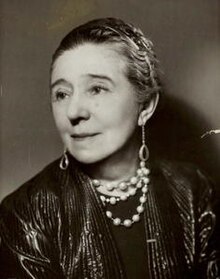
Summary
Jeanne-Marie Lanvin (French: [ʒan maʁi lɑ̃vɛ̃]; 1 January 1867 – 6 July 1946) was a French haute couture fashion designer. She founded the Lanvin fashion house and the beauty and perfume company Lanvin Parfums.
Jeanne-Marie Lanvin | |
|---|---|
 | |
| Born | 1 January 1867 Paris, France |
| Died | 6 July 1946 (aged 79) Paris, France |
| Occupation(s) | Couturière, fashion designer |
| Known for | Founder of Lanvin |
| Spouses |
Xavier Melet (m. 1907) |
| Children | 1 |
| Website | www |
Early life edit
Jeanne Lanvin was born in Paris on 1 January 1867, the eldest of 11 children of Constantin Lanvin and Sophie Deshayes. She became an apprentice milliner (hat maker) at Madame Félix in Paris at the age of 16. She trained with Suzanne Talbot and Caroline Montagne Roux before becoming a milliner on the rue du Faubourg Saint-Honoré in 1889.[1]
Career edit
In 1909, Lanvin joined the Syndicat de la Couture (fr), which marked her formal status as a couturière. The clothing Lanvin made for her daughter began to attract the attention of a number of wealthy people who requested copies for their own children. Soon, Lanvin was making dresses for their mothers, and some of the most famous names in Europe were included in the clientele of her new boutique on the rue du Faubourg Saint-Honoré in Paris.
From 1923, the Lanvin empire included a dye factory in Nanterre. In the 1920s, Lanvin opened shops devoted to home décor, menswear, furs and lingerie. Her most significant endeavour was the creation of Lanvin Parfums SA in 1924. Her signature fragrance, Arpège, introduced in 1927,[2] was inspired by the sound of her daughter Marguerite practicing her scales on the piano. (Arpège is French for arpeggio.)
In 1922, Lanvin collaborated with celebrated French designer Armand-Albert Rateau in redesigning her apartment, her homes and her businesses.[3] The living room, boudoir and bathroom of the apartment was reassembled in 1985 in the Musée des Arts Décoratifs, Paris. For this home, Rateau designed some remarkable 1920–22 furniture in bronze.[4]
The pair developed a friendship. Rateau came aboard Lanvin's empire as manager of Lanvin-Sport, designing the Lanvin spherical La Boule perfume flacon for Arpège, originally produced by the Manufacture Nationale de Sèvres. To this day, Arpège perfume globe, designed by Rateau, are imprinted with Paul Iribe's gold image (rendered in 1907) of Lanvin and her daughter Marguerite. Rateau also managed Lanvin-Décoration, an interior-design department established in 1920, in the main store on the rue du Faubourg Saint-Honoré.[4]
Personal life, death and legacy edit
In 1895, Lanvin married Count Emilio di Pietro, an Italian nobleman. Two years later she gave birth to a daughter, Marguerite (also known as Marie-Blanche) (1897–1958). The couple's only child, Marguerite di Pietro became an opera singer. She married the Count Jean de Polignac (1888–1943). On the death of her mother, she became the director of the Lanvin fashion house.[1]
Lanvin and di Pietro divorced in 1903. Lanvin married Xavier Melet in 1907, a journalist at the newspaper Les Temps and later the French consul in Manchester, England.[1]
Lanvin died on 6 July 1946. Her original office is preserved in Lanvin's corporate offices at 16 Rue Boissy d’Anglas in Paris.[5]
Awards edit
- Chevalier de l'Ordre de la Légion d'Honneur, to Jeanne Lanvin, 1926
- Officier de l'Ordre de la Légion d'Honneur, to Jeanne Lanvin, 1938[citation needed]
See also edit
- Lanvin (clothing) for more information on the fashion house
- Arpège
Collection at the Metropolitan Museum of Art, New York edit
-
"Roseraie", evening dress (silk), spring/summer 1923
-
"Jolibois", evening dress (silk), fall/winter 1922–23
-
Ko.I.Noor, evening ensemble (silk and metal), spring/summer 1927
-
"Phèdre", evening dress (silk and metal), fall/winter 1933
-
"Fusée", evening dress (silk), 1938
-
"Cyclone", evening dress (silk and spangles), 1939
References edit
- ^ a b c "Jeanne Lanvin (1867–1946)". perfumeprojects.com. Retrieved 5 August 2008.
- ^ "Lanvin, Jeanne (1867–1946)." Dictionary of Women Worldwide: 25,000 Women Through the Ages, edited by Anne Commire and Deborah Klezmer, vol. 1, Yorkin Publications, 2007, p. 1086. Gale eBooks. Accessed 16 Sept. 2021.
- ^ Polan, Brenda; Tredre, Roger (1 October 2009). The Great Fashion Designers. Berg. p. 31. ISBN 978-0-85785-175-8.
- ^ a b Mel Byars, 2004, p. 614.
- ^ Iredale, Jessica (27 February 2014). "Step into Jeanne Lanvin's Office". WWD. Retrieved 27 February 2014.
Sources edit
- Colette, Emilio Terry, et al. (1965). Homage à Marie-Blanche, Comtesse Jean de Polignac, Monaco.
- "Jeanne Lanvin" and "Claude Montana" in Morgan, Ann (1984). Contemporary Designers, New York: Macmillan. | ISBN 0-333-33524-4
- "Castillo", "Jules-François Crahay", and "Jean Gaumont-Lanvin" in Remaury, Bruno, director (1994). Dictionnaire de la Mode au XXe Siècle, Paris: Éditions du Regard. | ISBN 2-84105-181-1
- Barillé, Elisabeth (1997). Lanvin, Paris: Assouline. | ISBN 2-84323-015-2)
- Picon, Jérôme (2002). Jeanne Lanvin, Paris: Flammarion. | ISBN 2-08-210044-8
- "Armand Albert Rateau" and "Jeanne Lanvin" in Byars, Mel (2004). The Design Encyclopedia, New York: The Museum of Modern Art. | ISBN 0-87070-012-X
- Menkes, Suzy (24 May 2005). "At Lanvin, a master of improvisation", International Herald Tribune.
External links edit
- Lanvin home page
- Jeanne Lanvin at FMD
- Biography of Lanvin of Toutenparfum.com
- The 'Jeanne Lanvin' fragrance, named after Lanvin's founder, on the Lanvin Parfums website
- "Jeanne Lanvin – Evening gown". Victoria and Albert Museum. Retrieved 15 November 2007.
- "Interactive timeline of couture houses and couturier biographies". Victoria and Albert Museum. 29 July 2015.


